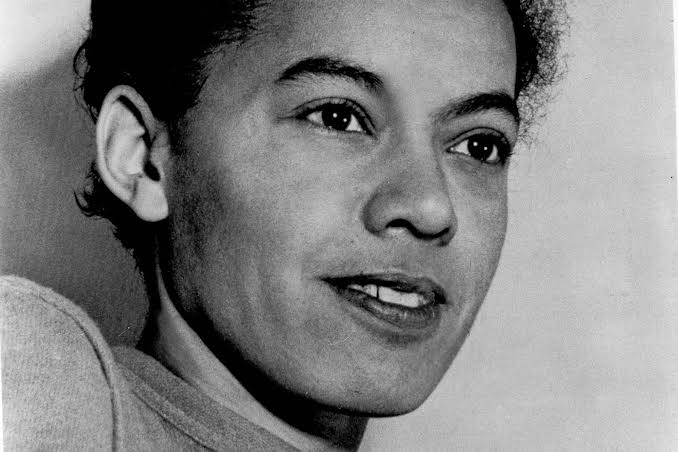A Larger Circle (1977)
In Langston Hughes’ poem, a mother tells her son, “Life for me ain’t been no crystal stair.” One who could well have related to the metaphor was a woman who had to combat the trifecta of racism, sexism, and homophobia. Despite the societal handicaps, Pauli Murray became the first African-American woman ordained as an Episcopal minister.
The woman who interacted with as many pivotal moments in American history as Forrest Gump was born in 1910 as Anna Pauline Murray; she preferred the name Pauli. She recalled of her formative years, “The most significant fact of my childhood was that I was an orphan.” At the age of three, Agnes, Pauli’s mother, suffered a cerebral hemorrhage on the family’s staircase and died on the spot. Three years later, her father, William, unable to cope with raising and supporting six children under the age of ten, entered the Crownsville State Hospital for the Negro Insane. In 1922, a white guard taunted him with racial epithets, dragged him to the basement, and beat him to death with a baseball bat. Twelve-year-old Pauli’s final glimpse of her father was as he lay in a casket, skull split open, sewed together with jagged stitches.
Bereft of parents, Pauli lived with her Aunt Pauline, after whom she had been named, in Durham, North Carolina, in the home of her maternal grandparents, Cornelia and Robert Fitzgerald. Cornelia had been born into bondage; her mother had been a part-Cherokee slave, her father the owner’s son and her grandmother’s rapist.
During high school, Murray impressed her teachers with her hunger for knowledge, and when she graduated at age fifteen, she was the editor of the newspaper, president of the literary society, class secretary, a member of the debate club, the top student, and a forward on the basketball team. With her impressive credentials, Pauli could have attended the North Carolina College for Negroes, but as her whole life had been colored by segregation, she did not want to attend a system dominated by Jim Crow. Pauli set her sights on Columbia University and prevailed upon her aunt to take her North. In New York, she realized her ethnicity was not the only barrier: Columbia did not admit women. As she could not afford Barnard, her third alternative was Hunter College, but it would not accept her transcript because black high schools in North Carolina did not offer the requisite courses. Murray persuaded her family to allow her to live with a cousin in Queens and attended Richmond High School where she was the only African-American in a student body of four thousand. Two years later, Pauli enrolled in the college-one open only open to women- a fact she viewed as another form of segregation. She rented a room in the Harlem Y.W.C.A. where she befriended Langston Hughes, met W.E.B. Du Bois, attended lectures by the civil-rights activist Mary McLeod Bethune, and visited the Apollo Theater to hear Duke Wellington and Cab Calloway. Pauli was living the life she had always envisioned; it came to an abrupt end with the onset of the Great Depression. She lost her job as a waitress and was unable to find another. By the end of her sophomore year, she had lost fifteen pounds and suffered from malnutrition. In solidarity with the hoboes, she rode with them across the country in freight trains.
In 1930, when Pauli was twenty-years-old, she met William Wynn, with whom she shared the commonalities of age, poverty, and separation from family in the South. After a brief courtship, the two married in secret and spent a less than fulfilling two-day honeymoon at a cheap hotel. Their “dreadful mistake” did not last the weekend. After the break-up, Pauli wrote in her diary, “Why is it when men try to make love to me, something in me fights?” The question was not merely rhetorical; she went to the New York Public Library and read every book on sexual deviance. Murray became convinced she was only attracted to women because “she had secreted male genitals.” Her awareness of her unconventional sexuality did not come as a shock. Her Aunt Pauline had referred to her as a “little boy-girl” as she had rejected her birth name Anna and dressed in boy’s clothes. Partially due to her same-sex leanings, from the time she was nineteen, she had a psychological breakdown resulting in hospitalizations. She wrote to a doctor, “Anything you can do to help me will be gratefully appreciated, because my life is somewhat unbearable in its present phase.” The climate of her era was not kind: until 1973, homosexuality was classified as a mental illness by the American Psychiatric Association.
Pauli’s only significant romance was with Irene Barlow, one that lasted a quarter of a century. Nevertheless, the couple never shared a residence and left behind no correspondence as Murray, otherwise a pack rat, destroyed their letters. She revealed little of their relationship in her 1987 memoir, Song in a Weary Throat: an American Pilgrimage, and only when Barlow lay dying of a brain tumor in 1973, did she describe her as “my closest friend.” In 1985, when Pauli passed away from cancer, her final resting place was a Brooklyn cemetery, where she shared a headstone with Irene.
Lacking employment, Murray applied to the graduate program in sociology at The University of North Carolina despite its whites-only policy. However, Murray saw a loophole: her slave- owning ancestor had served on its board of trustees. The school sent their decision, “Dear Miss Murray. I write to state that...members of your race are not admitted to the University.” Infuriated, the twenty-eight-year-old Pauli sent a letter of protest to President Roosevelt, but it was the First Lady who responded, “The South is changing, but don’t push too fast. There is a great change in youth, for instance, and this is a hopeful sign.” Thus began a decades-long correspondence between the radical Murray and the genteel First Lady who met at The White House and at Eleanor’s homes in New York City and Hyde Park. Murray influenced the FLOTUS to resign from the Daughters of the American Revolution after the organization refused to allow Marian Anderson to sing at Constitution Hall. Pauli also pleaded with Eleanor to have the president intervene when the court sentenced Odell Waller, a black Virginia sharecropper, to death. Murray delivered such a powerful speech on his behalf the audience-one of whom was Thurgood Marshall-was reduced to tears. Though Eleanor was swayed, FDR was not: Waller died in the electric chair.
The University of North Carolina never admitted Pauli, although she did get into two other notable American institutions: jail and law school. In 1940, Murray boarded a southbound bus in New York in order to spend Easter with her family in Durham. She and her friend, Adelene McBean, changed buses in Richmond, Virginia, and as the seats in the back were in disrepair, they sat closer to the front. When the driver asked them to move, they politely refused, and their road trip ended with their arrest. The NAACP wanted to use the incident to challenge the constitutionality of segregated travel; Virginia steered clear of the powder keg when Murray and Adelene only faced charges of disorderly conduct. The court found them guilty, fined them forty-three dollars; without funds, they again ended up behind bars.
Pauli enrolled in law school at the black Howard University, and although race was no longer an issue, her gender proved problematic as the professors and classmates were all male. When a professor remarked he didn’t know why a woman would enroll in law school, Pauli was determined to become its top student. She termed the school’s form of degradation “Jane Crow” and vowed to spend her life fighting sexism. In keeping with her promise, during the Nixon administration, she sent a letter to the president wherein she requested her appointment to the Supreme Court, knowing full well the futility of her application based on her race, gender, and sexuality.
After graduating, Murray applied to Harvard for graduate work and received a letter, “You are not of the sex entitled to be admitted to Harvard Law School.” Even President Roosevelt’s intercession bore no fruit, and she enrolled in Berkeley for her masters. With the prestigious degree under her belt, she headed for New York City; due to the negative light in which female attorneys were held, she had to subsist on low paying jobs. At last, in 1953, the law firm Paul, Weiss, Rifkind,, Wharton & Garrison hired her. Of its sixty-some attorneys, she was the only African-American and one of three women. (Two soon left, although a fourth briefly appeared by the name of Ruth Bader Ginsberg, a summer associate with whom Murray crossed paths.) Years later, as a member of the Supreme Court, Justice Ginsburg named Pauli as an honorary co-author in a brief based on her work on gender discrimination. In her final year in the corporation, Murray received the distinction of being able to practice before the United States Supreme Court. In 1960, frustrated with her work environment, she took a job at the recently opened Three years later Pauli encountered her fourth form of discrimination-ageism, when the church enforced their mandatory retirement at age of sixty-five. Not one to be idle, she worked in a smattering of fill-in preaching positions for twenty-five dollars a sermon. Although Pauli held four advanced degrees, had friends on the Supreme Court and in the White House, she died as she had lived, on the periphery of penury. Nevertheless,her trailblazing accomplishment in the Episcopal Church-followed by her 2012 sainthood, paved the way for fellow black women.
Rather than give in to the hydra heads of hate she had battled all her life, Murray’s message was one of love, “When my brothers try to draw a circle to exclude me, I shall draw a larger circle to include them.”
Ghana School of Law. When Ghana veered towards dictatorship, Pauli returned to the States, a country caught up in the civil rights movement. However, she spent most of her efforts in the women’s movement, from arguing sex-discrimination cases to serving on President Kennedy’s Presidential Commission on the Status of Women. Along with Betty Friedman, she was a founder of the National Organization for Women. A female Faustus, Murray attended Yale Law School, which, in 1965, awarded her Doctor of Juridical Science, the first African-American to be so recognized.
Dr. Murray was a tenured professor at Brandeis when she resigned her post at age sixty-two; she had decided her life’s calling was in the Episcopal ministry. In classic Pauli fashion, the position she sought was unavailable: the Episcopal Church did not ordain women. Fortunately, while in divinity school, its ecclesiastic branch voted to change their policy. In a ceremony in the National Cathedral, Murray became the first African-American woman to be vested as an Episcopal priest; the clergy ordained Pauli at the National Cathedral in Washington. A month later, Reverend Murphy administered her first Eucharist at the Chapel of the Cross-the little church in North Carolina where, a century earlier, a priest had baptized her grandmother Cornelia, a slave, one of the servant children belonging to Miss Mary Ruffin Smith.


